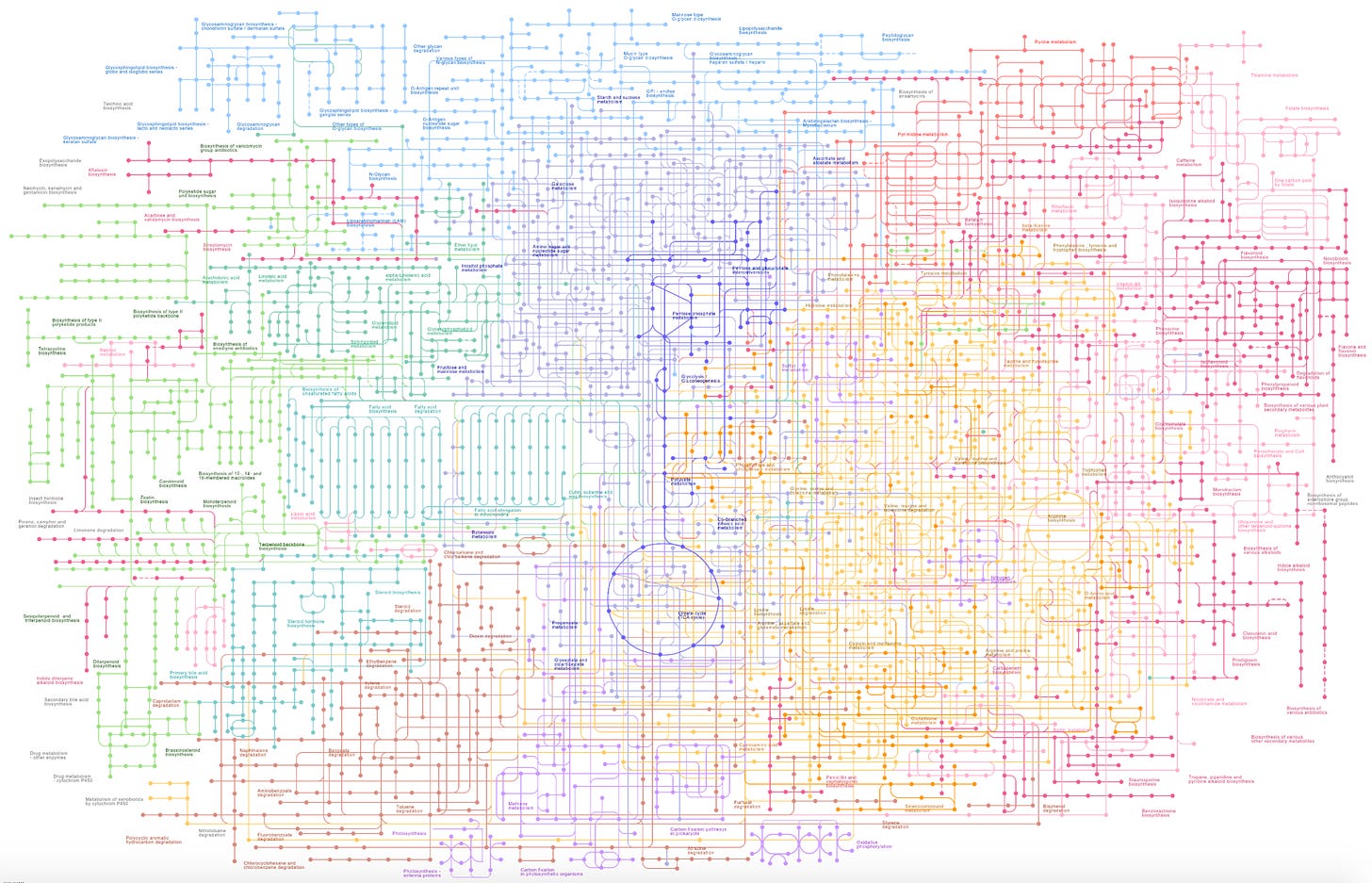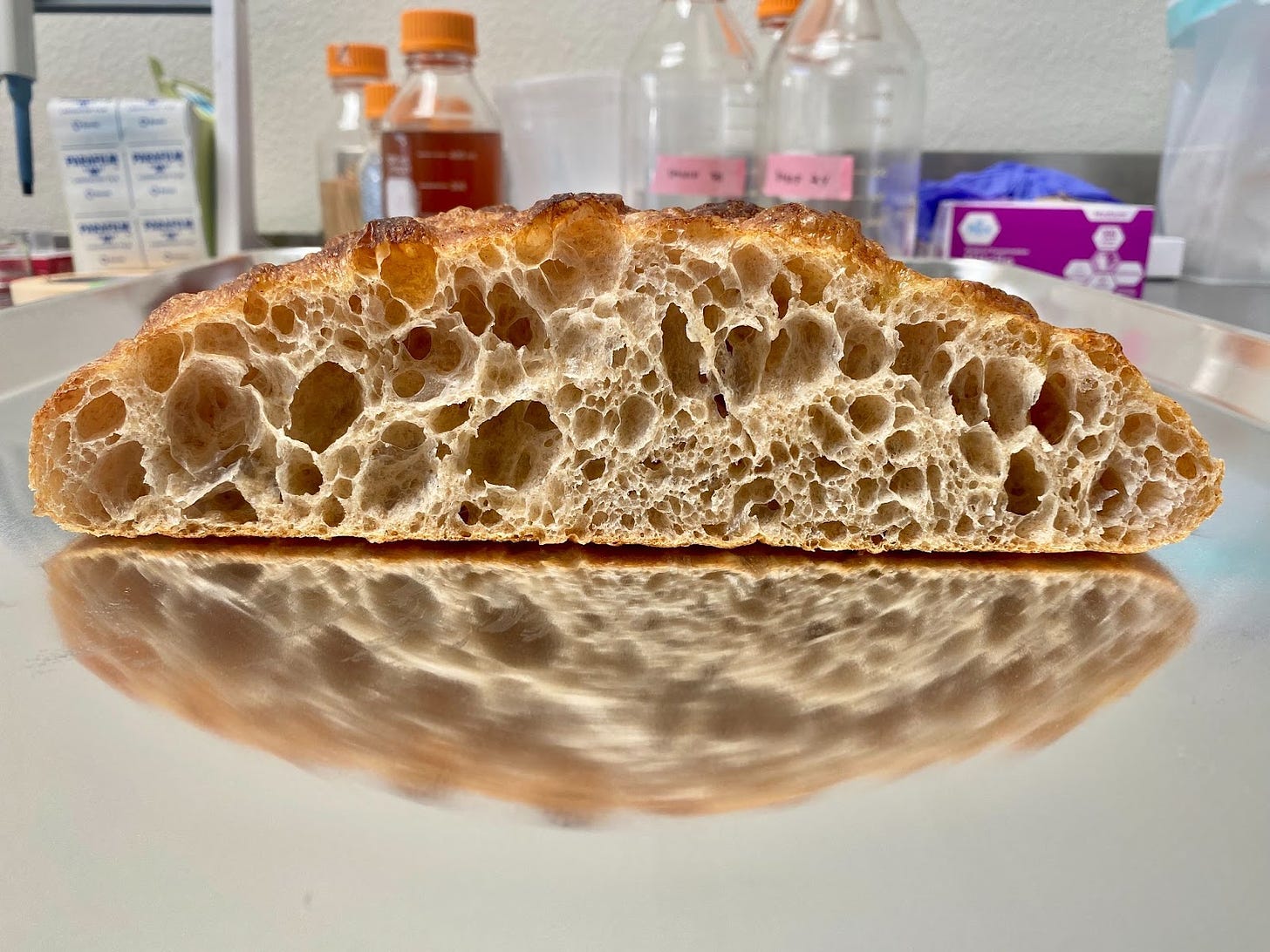by Eric Ferias

Written on behalf of Leaven Foods, blog found on Substack, along with Cameron Martino and James Gaffney, Co-Founders of Leaven.
In baking, the predominant focus is on grain from the botanical family of grasses called Poaceae. This diverse family includes corn, rice, oats, sorghum, teff, millet, wheat, rye, and barley, amongst others. When a baker ferments dough, they are carefully guiding the natural decomposition process of the kernel (seed) from these grasses. To understand how, we must first understand the components that make up the kernel.

Chemistry of Cereals
Anatomically, the kernel, or the berry of these grasses, is made up of three main parts: the bran or pericarp, the endosperm, and the germ.

The bran is a multilayered, waterproof shell that protects the kernel. It is largely composed of non-soluble fiber and is rich in vitamins, proteins, and minerals (Khalid, Hameed, and Tahir 2023). Phenolics, tannins, and flavonoids are present in bran which, in their natural state or when altered by microorganisms, can enhance flavor and confer nutritional benefits to whole grain products (Gianotti et al. 2011; Brouns et al. 2012; Garcia-Vaquero and Rocha 2023).
The germ is the dormant seed that contains proteins, carbohydrates, fats, minerals, fiber, and genetic information necessary for plant propagation. Minor constituents of the germ include bioactive compounds such as phenolics, carotenoids, and “healthy” lipids such as phytosterols (Brandolini and Hidalgo 2012). Due to the high-fat content, the germ is often removed during milling as oxidation of germ fats can cause flour to become rancid (Piras et al. 2009; Brandolini and Hidalgo 2012).
The final component of the kernel is the endosperm, which makes up the bulk of the grain’s weight and predominantly contains carbohydrates in the form of starch granules. These granules consist of two water-soluble, long-chain glucose structures called amylose and amylopectin. A starch granule is usually made up of 10-30% amylose and 70-90% amylopectin.

The first step of the decomposition process is hydration–all life requires water to be active, and microbes are no different. To ensure even distribution of the components listed above, the components are milled into flour, a process as old as recorded human history.
Microbial Biochemistry
Now that we understand the components of the flour, we will cover how the decomposition of these compounds through microbes occurs. Upon hydration of flour, enzymes (amylases) in the kernel act to degrade endosperm-derived starch into smaller sugars, which can act to feed microorganisms (van Rooyen et al., 2023). The fermentation of starch-derived sugars is often depicted in a simplified manner: lactic acid-producing bacteria (LAB) and yeasts collaborate to degrade and ferment sugars resulting in the generation of carbon dioxide, ethanol (alcohol), and organic acids, including lactic and acetic acid. In turn, carbon dioxide contributes to bread leavening, while ethanol and acids provide flavor and aroma.
This simplification effectively describes the main byproducts of sourdough fermentation and the origins of dough leavening but falls short of encompassing the broad range of microbial functionality. We will attempt to summarize it here but much is still not well understood about the process and some level of gross generalization is required due to the complexity of microbial metabolism. To drive this point home, pictured below is a map of all the biochemistry that can be performed by a bacteria in its entirety.

As flour is decomposed by microbes, aroma and flavor are influenced. Organic acids such as lactic, acetic, and succinic acids resulting from LAB fermentation of carbohydrates give sourdough its distinctive sour flavor. Phenolic compounds, predominantly found in the bran, are released and transformed by microbes and contribute to what has been described as malty, roasty, and bitter flavors (Boudaoud et al. 2021; De Vuyst et al. 2016; Gänzle 2014; Gobbetti et al. 2019; Garcia-Vaquero and Rocha 2023; Rodriguez et al. 2009). Esters, non-ethanol alcohols, aldehydes, and ketones are synthesized via microbial fermentation of carbohydrates from the endosperm and metabolism of lipids (fats) and proteins in the germ. (Pico, Bernal, and Gómez 2015; De Vuyst et al. 2016; Petel et al. 2017). These metabolites impart a wide variety of aromas and flavors to bread including fruity, sweet, buttery, earthy, and spicy (Pico, Bernal, and Gómez 2015).

As the decomposition progresses, structural properties of dough such as volume, elasticity, crumb structure, springiness, gumminess, and chewiness are altered. Exopolysaccharides (EPS), a class of polysaccharides (sugars) are synthesized by sourdough LAB and enhance bread volume and texture (Chen, Levy, and Gänzle 2016; Abedfar, Hosseininezhad, and Rafe 2020). Similarly, glycerol produced by sourdough yeasts are generated and influence dough extensibility and volume (Aslankoohi et al. 2015). As the dough becomes more acidic, protein-degrading enzymes in flour and from microbes become active, and protein, including gluten, is degraded yielding softer dough. (Gobbetti et al. 2019; Garcia-Vaquero and Rocha 2023; Arendt, Ryan, and Dal Bello 2007).
Apart from impacting sensory qualities, the decomposition process confers nutritional benefits. Phenolic compounds that enhance flavor and aroma, also act as antioxidants (Gobbetti et al. 2019; Gobbetti and Gänzle 2023). As flour is broken down the glycemic index of bread is reduced by various mechanisms involving phenolics, organic acids, and degradation of starch and protein (Gobbetti et al. 2019; Arora et al. 2021). Similar to protein degrading enzymes, acidification of dough by organic acids activates phytases. These enzymes found in flour and produced by yeast act to enhance the bioavailability of minerals including iron, calcium, zinc, sodium, and others (De Vuyst, Van Kerrebroeck, and Leroy 2017; Arora et al. 2021).
All this complex biochemistry, a controlled decomposition, happens each time you make your sourdough. Hopefully, giving us all a new appreciation and adding some additional beauty to the process.

This is the second post in the series inspired by Leaven Foods’ Founder Cameron Martino’s lectures on Applied Microbiology for Bakers, hosted by Noel Brohner and Justin Dray of Slow Rise Pizza Co. For Part I, where we discuss the microbial diversity of sourdough starters, click here. Now that we have the broad strokes covered, stay tuned as we delve more deeply into more specific topics in the science of sourdough.
References
Abedfar, Abbas, Marzieh Hosseininezhad, and Ali Rafe. 2020. “Effect of Microbial Exopolysaccharide on Wheat Bran Sourdough: Rheological, Thermal and Microstructural Characteristics.” International Journal of Biological Macromolecules 154 (July): 371–79.
Arendt, Elke K., Liam A. M. Ryan, and Fabio Dal Bello. 2007. “Impact of Sourdough on the Texture of Bread.” Food Microbiology 24 (2): 165–74.
Arora, Kashika, Ameur, Hana, Polo, Andrea, Di Cagno, Raffaella, Rizzello, Carlo, Gobbetti, Marco. 2021.“Thirty years of knowledge on sourdough fermentation: A systematic review”. Trends in Food Science and Technology. 108: 71-83.
Aslankoohi, Elham, Mohammad Naser Rezaei, Yannick Vervoort, Christophe M. Courtin, and Kevin J. Verstrepen. 2015. “Glycerol Production by Fermenting Yeast Cells Is Essential for Optimal Bread Dough Fermentation.” PloS One 10 (3): e0119364.
Boudaoud, Sonia, Chahinez Aouf, Hugo Devillers, Delphine Sicard, and Diego Segond. 2021. “Sourdough Yeast-Bacteria Interactions Can Change Ferulic Acid Metabolism during Fermentation.” Food Microbiology 98 (September): 103790.
Brandolini A, Hidalgo A. Wheat germ: not only a by-product. Int J Food Sci Nutr. 2012 Mar;63 Suppl 1:71-4.
Brouns, Fred, Youna Hemery, Ruth Price, and Nuria Mateo Anson. 2012. “Wheat Aleurone: Separation, Composition, Health Aspects, and Potential Food Use.” Critical Reviews in Food Science and Nutrition 52 (6): 553–68.
Chen, Xiao Yan, Clemens Levy, and Michael G. Gänzle. 2016. “Structure-Function Relationships of Bacterial and Enzymatically Produced Reuterans and Dextran in Sourdough Bread Baking Application.” International Journal of Food Microbiology 239 (December): 95–102.
De Vuyst, Luc, Henning Harth, Simon Van Kerrebroeck, and Frédéric Leroy. 2016. “Yeast Diversity of Sourdoughs and Associated Metabolic Properties and Functionalities.” International Journal of Food Microbiology 239 (December): 26–34.
De Vuyst, Luc, Simon Van Kerrebroeck, and Frédéric Leroy. 2017. “Microbial Ecology and Process Technology of Sourdough Fermentation.” Advances in Applied Microbiology 100 (April): 49–160.
Gänzle, Michael G. 2014. “Enzymatic and Bacterial Conversions during Sourdough Fermentation.” Food Microbiology 37 (February): 2–10.
Garcia-Vaquero, Marco, and João Miguel F. Rocha. 2023. Sourdough Innovations: Novel Uses of Metabolites, Enzymes, and Microbiota from Sourdough Processing. CRC Press.
Gianotti, Andrea, Francesca Danesi, Vito Verardo, Diana Isabella Serrazanetti, Veronica Valli, Alessandra Russo, Ylenia Riciputi, et al. 2011. “Role of Cereal Type and Processing in Whole Grain in Vivo Protection from Oxidative Stress.” Frontiers in Bioscience 16 (5): 1609–18.
Gobbetti, Marco, Maria De Angelis, Raffaella Di Cagno, Maria Calasso, Gabriele Archetti, and Carlo Giuseppe Rizzello. 2019. “Novel Insights on the Functional/nutritional Features of the Sourdough Fermentation.” International Journal of Food Microbiology 302 (August): 103–13.
Gobbetti, Marco, and Michael Gänzle. 2023. Handbook on Sourdough Biotechnology. Springer Nature.
Khalid, Anam, Amjad Hameed, and Muhammad Farrukh Tahir. 2023. “Wheat Quality: A Review on Chemical Composition, Nutritional Attributes, Grain Anatomy, Types, Classification, and Function of Seed Storage Proteins in Bread Making Quality.” Frontiers in Nutrition 10 (February): 1053196.
Petel, Cecile, Onno, Bernard, Prost Carole. 2017. “Sourdough volatile compounds and their contribution to bread: A review” Trends in Food Science & Technology 59: 105-23.
Pico, Joana, José Bernal, and Manuel Gómez. 2015. “Wheat Bread Aroma Compounds in Crumb and Crust: A Review.” Food Research International 75 (September): 200–215.
Piras A, Rosa A, Falconieri D, Porcedda S, Dessì MA, Marongiu B. Extraction of oil from wheat germ by supercritical CO2. Molecules. 2009 Jul 15;14(7):2573-81.
Rodríguez H, Curiel JA, Landete JM, de las Rivas B, López de Felipe F, Gómez-Cordovés C, Mancheño JM, Muñoz R. Food phenolics and lactic acid bacteria. Int J Food Microbiol. 2009 Jun 30;132(2-3):79-90.
Rooyen, Jana van, Senay Simsek, Samson A. Oyeyinka, and Marena Manley. 2023. “Wheat Starch Structure-Function Relationship in Breadmaking: A Review.” Comprehensive Reviews in Food Science and Food Safety 22 (3): 2292–2309.

